mobile View, to the German Version tap the flag


- 1798–1918 Principality of Schaumburg-Lippe
- 1918–1946 Free State of Schaumburg-Lippe
- former country of the German Empire
- 1946 incorporated to Lower Saxony
• Flags
• Meaning/Origin of the Flag
• Coat of Arms
• Meaning/Origin of the Coat of Arms
• Cockade
• Map
• Numbers and Facts
• History
• Origin of the Country's Name
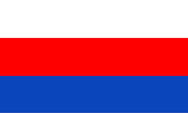
to 1934,
Colours of the country and State flag,
ratio = 3:5,
Source, by: World Statesmen



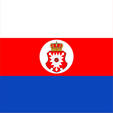
1880–1911,
Flag of the Prince,
Source, by: Flags of the World,
Deutsche Wappen Rolle



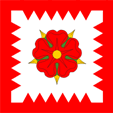
1911–1918,
Flag of the Prince,
Source, by: Flags of the World



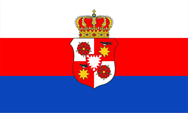
Today's ceremonial flag at princely Castle in Bückeburg ,
ratio = 3:5,
Source: Dr. Lichtblau




1949–1977,
Flag of the District of Schaumburg-Lippe,
ratio = 3:5,
Source: Dr. Lichtblau



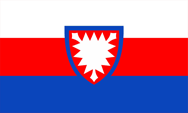
since 1977,
Flag of the District of Schaumburg,
ratio = 3:5,
Source: Dr. Lichtblau




The colours of Schaumburg-Lippe were white, red and blue, but they were not before 1922 officially defined and introduced. There exist representations of the flag in a color reversal in blue, red and white, for the period before the year 1880. They are justified by a failure of the former Düsseldorf manufacturer.
Probably the colours are derived from the coat of arms of the County of Schaumburg, a silvery (white) nettle leaf on red, which was sometimes depicted with a blue border. It is further possible that the house-colors of the House of Lippe-Alverdissen could hide behind it, from which the House of Schaumburg-Lippe descents. The middle coat of arms of Schaumburg-Lippe showed a red central-shield, in its middle often appeared a smaller shield that sometimes shows the colors silver and red, sometimes even blue and red, which could could stand for the house-colours of the ruling family.
Another incident for the flag was the seizure of power by the National Socialists in the German Empire in 1933. All official non-swastika flags, that refered to federalism, regional references or the old German Empire were abolished between 1933 and 1935. For the National Socialists, the federal structure of the German Empire, its historically grown countries, was considered as outdated, as relics of a past to be overcome. In this sense, several laws were enacted, on 31st of March in 1933 the 'Provisional Law for the phasing of the countries with the Empire', on 7th of April 1933 the 'Second Law for the phasing of the countries with the Empire' and finally, on 30th January in 1934 the 'Law on the rebuilding of the empire'. Thus, the federal structure of the German Empire was replaced by the gau-structure of the NSDAP, the countries became meaningless. From now on, offices and authorities had to use the swastika flag as official flag, until September 15th in 1935, when by the flag-law was legislated a new created official flag for all the offices and authorities of the empire. The prime ministers of the countries, which latest in 1933 all came from the NSDAP – now mostly called Reichsstatthalter (maybe translated as 'governor') – however remained in office until 1945. The corresponding country colours continued, with restrictions, but definitly not in the form of flags. They were used, for example, occasionally on uniforms of the SA or in some ranks of the Hitler Youth in the breast cord.
After the war, the administration within the German Empire was rebuilt, but locally, following the structure of the countries. These have been partly old countries, and some new countries were created. Sometimes they bethought the old country colours and reactivated them – or they created new ones – for limited sovereign duties, which were under the control of the Allies. With the founding of the FRG and the GDR, an internal country-structure was finalised for both entities and corresponding official flags were introduced for these countries.
Source: Volker Preuß,
World Statesmen

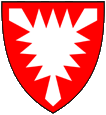
Coat of arms of the Counts of Schaumburg,
Source, by: Wikipedia (D)
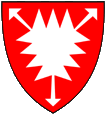
13th century to 1601,
Coat of arms of the County of Schaumburg,
Source, by: Wikipedia (D)

1601–1807,
middle coat of arms of the County of Schaumburg-Lippe,
Source, by: www.heraldique.org

1807–1904,
middle coat of arms of the Principality of Schaumburg-Lippe,
Source, by: historical illustration

19th century,
lesser coat of arms of the Principality of Schaumburg-Lippe,
Source, by: historical illustration

19th century,
lesser coat of arms of the Principality of Schaumburg-Lippe,
Source, by: historical illustration

1904–1918,
lesser coat of arms of the Principality of Schaumburg-Lippe,
Source, by: Brockhaus Konversationslexikon

1904–1918,
middle coat of arms of the Principality of Schaumburg-Lippe,
Source, by: historical illustration
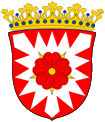
1918–1946,
Coat of arms of the Free State of Schaumburg-Lippe,
Source, by: png erstellt von N3MO / Public domain

since 1977,
Coat of arms of the District of Schaumburg,
Source, by: www.schaumburg.de

An important component of the coat of arms of the country was the silvery nettle leaf on red, the heraldry of the ancient County of Schauenburg, which came in 1647 to the House of Lippe-Alverdissen, after the extinction of the Counts of Schauenburg (from 1485 called Schaumburg). Already in the 13th century the corners of the nettle leaf were reproduced very expressive, and even interpreted as nails. Count Adolf IV. in 1238 was a participant in a crusade in Livonia. A legend claims that he had ordered to reproduce the corners of his arms as nails, to commemorate the three nails on the cross of Jesus Christ, and in thus to represent his piety. If it is a legend, it has nevertheless left its mark, because deep into the 19th century the three nails were shown in the coat of arms.
When the Line of Lippe-Alverdissen in 1647 took over the County of Schaumburg, was put on the coat of arms of the House of Lippe the coat of arms of the county as a central shield, with a silvery, stylized nettle leaf and three silvery nails on red, but there is placed in the middle of the nettle leaf a further small shield, which probably shows the house colors of the House of Lippe-Alverdissen, white and red, but sometimes even blue and red. This central shield was used as small coat of arms by Schaumburg-Lippe, and in practice very often used in this way, but then showed the little shield on the nettle leaf even the 'Lippe Rose', sometimes alone in silver, sometimes, when the small shield showed the colors silver (white) and red, also in the white field.
Also the prince's crown showed over the years very different designs, sometimes as a princely hut, sometimes as a crown, and from the year 1904 even as the royal crown. In that year the coat of arms was fixed by law: the nails in the corners of the nettle leaf were abolished, and in the small coat of arms the 'Lippe Rose' was placed directly on the nettle leaf. The Free State of Schaumburg-Lippe took over the small coat of arms, however, the prince's crown became replaced by the 'People's crown'. The District of Schaumburg waives the crown and the 'Lippe Rose', but the crest is surrounded by a blue border, which has been showed from time to time in this way, and so reminiscent to the colours of the country, white, red and blue.
Source: Schaumburg.de,
Hubert Herald,
Volker Preuß,
Verordnung betreffend das Fürstlich Schaumburg-Lippische Staatswappen vom 27. Mai 1904
Lesen Sie hier:
Hintergründe, Geschichte und Fakten zum Thema "Der Löwe in der Heraldik". Ausführungen, Varianten, Entwicklung, sowie Panther und Leoparden.



to 1919,
Cockade of Schaumburg-Lippe,
Source, by: historical illustration
Read here:
Informations, history and facts about the theme "Cockades".

Cockade

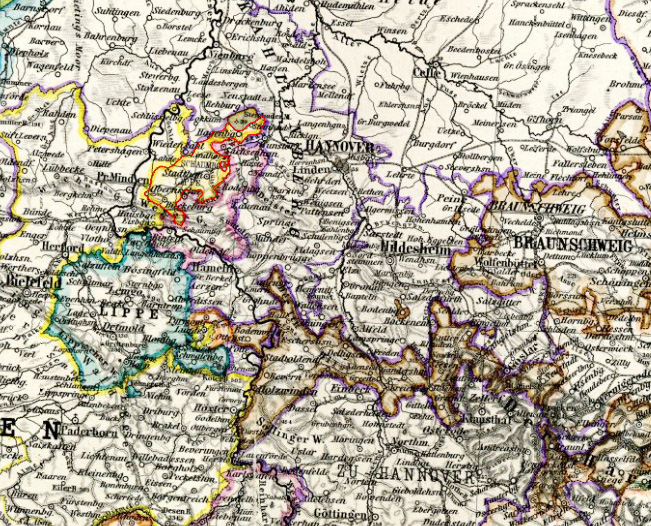
Source: Stielers Hand-Atlas, Justus Perthes, 1891
modyfied by: Volker Preuß
The map shows the Principality of Schaumburg-Lippe ca. 1865 within a thin red border, in the southeast of it, within a lila-colored border of the (then) Hessian 'District County of Schaumburg-Lippe'

Area: 131 square miles
Inhabitants: 26.300 (1816), 44.000 (1905), 48.000 (1925)
Density of Population: 366 inh./sq.mi. (1925)
Capital: Bückeburg, 4.200 inh. (1871)
Currency to 1847: 1 Taler = 36 Groschen = 216 Pfennige
Currency 1847–1875: 1 Taler = 30 Groschen = 360 Pfennige
Currency 1875–1924: 1 Mark = 100 Pfennig
Currency 1924–1947: 1 Reichsmark (RM) = 100 Reichspfennig (Rpf.)
Source: HGISG Geoinform,
Der Michel,
Wikipedia (D)

12th century · first mention of the Lords of Schauenburg
1110 · the Lords of Schauenburg get Holstein as fiefdom
1295 · the Lords of Schauenburg get levied to Imperial Counts
ca. 1485 · the name Schauenburg is officially first mentioned as Schaumburg
1640 · death of Count Otto V. of Schaumburg without heirs
1644 · the heritage goes to Count Philipp of Lippe-Alverdissen (brother of the mother of Otto)
1646 · death of the mother of Otto, inheritances, the County of Holstein-Pinneberg goes to Christian IV. of Denmark, Gehmen (Westphalia) goes to the Duke of Limburg, the county Sternberg goes to the Counts of Lippe, Bergen (Netherlands) is sold, the County of Schaumburg becomes divided in 1647: Lauenau, Mesmerode and Bokeloh go to Brunswick-Lueneburg, Schaumburg, Rodenberg and Sachsenhagen go as 'District of County Schaumburg' to the Landgraviate of Hesse; Bueckeburg, Arensburg, Stadthagen and Hagenburg become summarized as County of Schaumburg-Lippe under a branch of the family-line of the House of Lippe-Alverdissen
1681 · death of Philip of Schaumburg-Lippe-Alverdissen, the inheritance is divided between the two sons, Friedrich Christian takes Schaumburg-Lippe, Philipp Ernst, the line of Alverdissen
1777 · death of William of Lippe-Alverdissen, the inheritance goes to Schaumburg-Lippe
1792, 1796, 1800 and 1805 · invasions of French revolutionary troops under Napoleon in the German Empire, the German Empire subjectes and becomes territorially transformed
1803 · German Mediatisation (Reichsdeputationshauptschluss), transformation of the territorial partition of the German Empire, ecclesiastical possessions become confiscated, old princely territories and free cities become confiscated or dissolved or annexed to old or new principalities, the number of sovereign authorities and territorial entities of the empire is thus reduced from 300 to 60
12th of July in 1806 · Napoleon forces the creation of the Rhine Confederation, an alliance of sixteen southern and southwestern German states under French protectorate
1st of August 1806 · the states of the Rhine Confederation declare themselves sovereign and resign from the Holy Roman Empire of German Nation
6th of August in 1806 · Emperor Franz II. lays down the crown of the Holy Roman Empire of German Nation, the empire ends
18th of April in 1807 · Schaumburg-Lippe joins the Rhine Confederation, the Count of Schaumburg-Lippe becomes levied to the rank of a Prince
October 1813 · Napoleon's defeat at Leipzig, the Rhine Confederation begins to fall apart, Napoleon and his troops withdraw behind the Rhine River
1814–1815 · Congress of Vienna, reconstruction of Europe after the era of Napoleon, the ownership and the administrative partitions in the former German Empire become restored, but not the sovereignty of the ecclesiastical countries, their possessions become transferred to old or new principalities, the 39 remaining German states – in this way Schaumburg-Lippe too – become organized in a loose association, the German Confederation
1866 · German war (civil war), Prussia and its allies against Austria and its allies, Prussia wins, the Principality of Schaumburg-Lippe is on the side of Prussia, join of the North German Confederation, the Hessian 'District of County Schaumburg' becomes a part of the Prussian Province of Hesse-Nassau
1868 · introduction of a constitution
1871 · joining of the Principality of Schaumburg-Lippe to the German Empire
15th of November in 1918 · overthrow of the monarchy, establishing of the Free State of Schaumburg-Lippe
1932 · the 'District of County Schaumburg' becomes annexed to the Province of Hanover
1934 · the territorial structure of the states of the German Empire becomes replaced by the districts of the NSDAP, the countries become meaningless
1945 · occupation by British and American troops
1st of November in 1946 · dissolution of the Free State of Schaumburg-Lippe, Schaumburg-Lippe becomes annexed as District of Schaumburg-Lippe to the Country of Lower Saxony (Schaumburg-Lippe, Hanover, Brunswick and Oldenburg)
19th of January in 1975 · a referendum for the restoration of the Country of Schaumburg-Lippe is dismissed
1st of August in 1977 · the District of Schaumburg-Lippe (Stadthagen) becomes merged with the District of County Schaumburg (Rinteln) to the District of Schaumburg
Source: Wikipedia (D),
World Statesmen,
Royalty Guide

The name of the country goes back to the Schauenburg Castle, the ancestral seat of the Lords of Schauenburg. Towards the end of the 15th century the name Schauenburg was abraded to Schaumburg, and became transferred in this way to the country and the ruling family of the House of Lippe.
Source: Wikipedia (D)







Kindly supported by: Dr. Lichtblau (D)
![]()

































